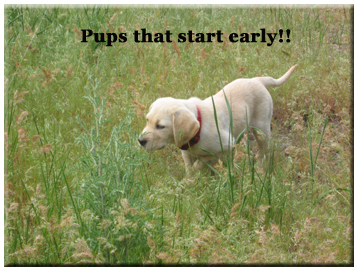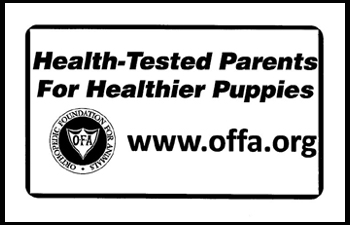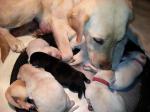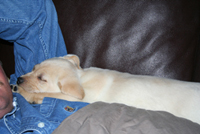FAQ's

Which Gun Dog Puppy For You?
Sixteen different top gun dog breeders chime in with their puppy selection tips...
|
|
Selecting a future hunting buddy can be a confusing process if you're not sure of what to look for. In this online exclusive running in conjunction with the PRO TIPS column appearing in the March/April/May 2011 issue of GUN DOG titled Which One, sixteen different breeders give insight on how they handle the puppy selection process for the breeds they specialize in.
John Greer of Tiger Mountain Pointing Labradors: Ellensburg, WA 98926; (509) 929-4032; Web site: www.pointinglabs.com; e-mail: tigermtnpl@gmail.com.
John has bred Labradors for 30 years.
"We place our puppies at seven weeks," John said, "but only after we have completed our weeklong puppy evaluation program in the field with birds."
John said they welcome scheduled visits before selection day for buyers who want to see their older dogs, their training program and their farm. But they don't let visitors enter the whelping barn, where their current litter is.
Tiger Mountain knows each puppy well, especially after the week in the field on birds. They become familiar with each buyer through questions and conversations with him.
"We inquire about his family life, hunting habits, goals for the puppy, and field trial and hunt test experience and plans," John said.
With that knowledge, they place each puppy with the buyer for whom that puppy makes the best match.
"Rapport will grow as the two get better acquainted and bond with one another," he noted.
Tiger Mountain recommends selecting a breeder whose program you have confidence in. A conscientious breeder will be there to help you through your puppy's rearing and training process.

Q: How do you determine the order of picks when buying a puppy?
A: Order of picks is determined on a first-come-first-serve basis. We put your name down in the order your deposit has been received. Once we have received your deposit, your name is placed on the pick list according to the type of puppy you've chosen (color and gender). All the pups in the litter will be pre-selected for you by us based upon your preferences to not only color/gender but to demeanor, disposition, family life, type of hunting, etc, etc. If the puppy you choose isn't born or is born but doesn’t pass our Puppy Evaluation Program, we'll move your deposit to another litter.
Q: Once my puppy is born... what's the earliest you recommend we come to see the litter.
A: We offer “visitation”, to see our dogs and any older pups but our litters are after the pups are vaccinated and are 7 weeks old, basically pickup day. Please wear appropriate clothing/shoes. No one, outside of ourselves, is allowed in the whelping barn. All pups are pre-determined for their new homes by us.
Q: What do I need to do in order to put a deposit down on a puppy?
A: Please email for our Puppy Reservation Form.
Q: If I buy a puppy from you are there training spots available?
A: We have a waiting list pretty much year round. In order to get on the list, we require the first month’s training fee ($800) in advance to put your name on the list. We recommend you put the deposit down when you buy your puppy or started dog, etc.
Early Spay-Neuter Considerations for the Canine Athlete
One Veterinarian's Opinion
© 2005 Chris Zink DVM, PhD, DACVP
Orthopedic Considerations
A study by Salmeri et al in 1991 found that bitches spayed at 7 weeks grew significantly taller than those spayed at 7 months, who were taller than those not spayed (or presumably spayed after the growth plates had closed). A study of 1444 Golden Retrievers performed in 1998 and 1999 also found bitches and dogs spayed and neutered at less than a year of age were significantly taller than those spayed or neutered at more than a year of age. The sex hormones, by communicating with a number of other growth-related hormones, promote the closure of the growth plates at puberty, so the bones of dogs or bitches neutered or spayed before puberty continue to grow. Dogs that have been spayed or neutered well before puberty can frequently be identified by their longer limbs, lighter bone structure, narrow chests and narrow skulls. This abnormal growth frequently results in significant alterations in body proportions and particularly the lengths (and therefore weights) of certain bones relative to others. For example, if the femur has achieved its genetically determined normal length at 8 months when a dog gets spayed or neutered, but the tibia, which normally stops growing at 12 to 14 months of age continues to grow, then an abnormal angle may develop at the stifle. In addition, with the extra growth, the lower leg below the stifle likely becomes heavier (because it is longer), and may cause increased stresses on the cranial cruciate ligament. In addition, sex hormones are critical for achieving peak bone density. These structural and physiological alterations may be the reason why at least one recent study showed that spayed and neutered dogs had a higher incidence of CCL rupture.
For the complete article, please visit Canine Sports Productions: http://www.caninesports.com/SpayNeuter.html
Dr. Zink is the author of Peak Performance: Coaching the Canine Athlete
A Healthier Respect for Ovaries
http://www.gpmcf.org/respectovaries.html
Skunk Rinse Recipe
Tomato juice isn’t nearly as effective as this recipe, and it’s easy to follow.
In a pail mix:
1 quart hydrogen peroxide (the 3 percent hydrogen peroxide variety)
¼ cup baking soda
2 teaspoons Dawn dishwashing liquid
If you have a large breed dog, you may need to double, triple or even quadruple the mixture.
Wear dishwashing or other household gloves [...]




